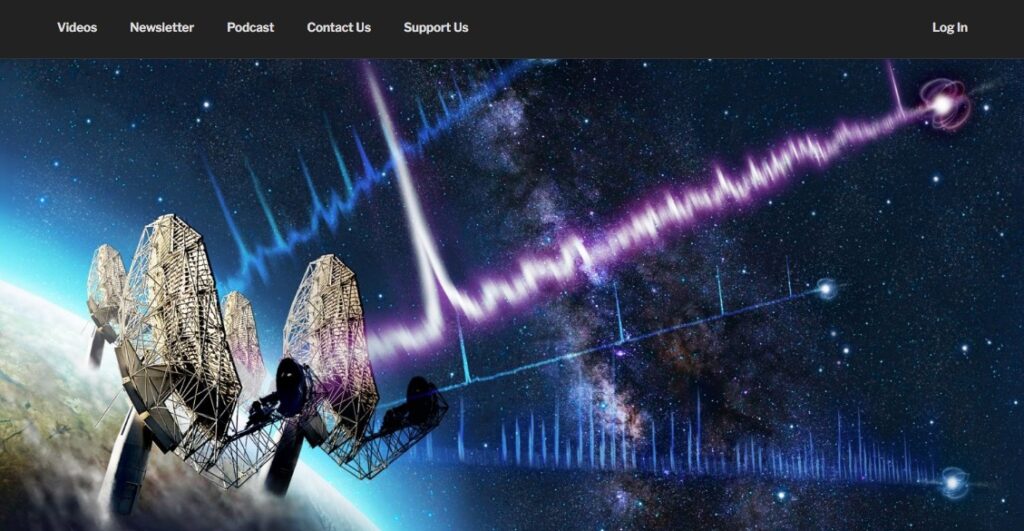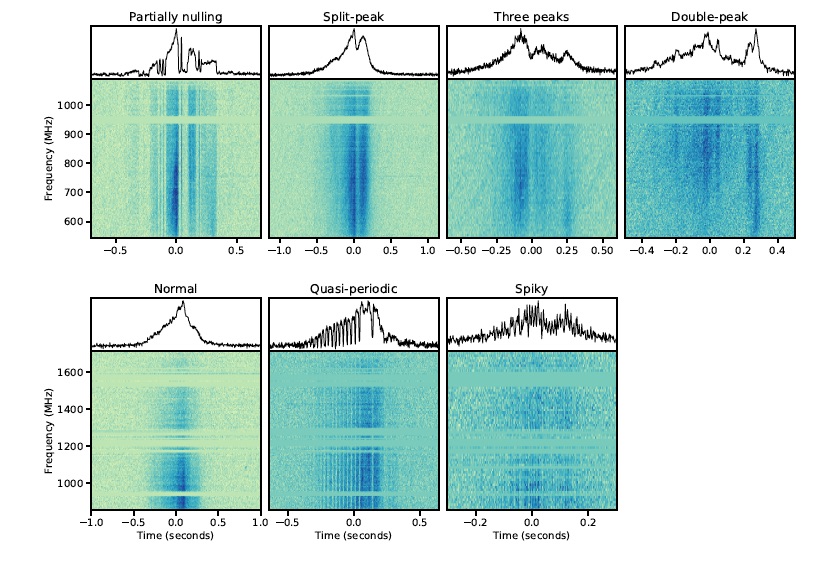Posted by: P. LaViolette
June 9, 2022
Updated: June 14 ,2022
On May 30, 2022, a consortium of astronomers led by Manisha Caleb published an important paper in Nature Astronomy journal of the discovery of PSR J0901-4046, a radio pulsar with a 76 second pulse repetition period. This pulsar calls attention to itself by sending out a bright pulse of radio emission every 76 seconds, the pulse lasting anywhere from about half to one second in duration. This finding puts one more nail in the coffin of the lighthouse pulsar theory. This is the standard narravive that mainstream astronomy that a radio pulsar is a rotating neutron star that emits a beam of relativistic electrons and synchrotron radio emission sweeping this beam in a circle as it rotates. The theory claims that the energy to power its relativistic electron beam is drawn from the store of its rotational kinetic energy. Most radio pulsars have relatively short pulse periods ranging anywhere from a few miliseconds to 3 or 4 seconds. The problem with finding a pulsar with a period of 76 seconds is that it would have to be rotating so slow that it would have far too little energy to power its radio beam. So, this pulsar leaves the lighthouse theory so to speak “dead in the spatial waters”. It would be spinning so slow that it should be unable to generate any radio emission, but it does.
This pulsar then further confirms what Paul LaViolette had pointed out as early as 2000 that pulsars are not spinning neutron stars, but X-ray stars, energetic stellar cores, that radiate a continuous stream of cosmic ray electrons in all directions. Remotely projecting EM force to locations near such stars is able to produce a non rotating radio synchrotron beam targeted towards a specific location in the Galaxy or even multiple beams targeted to multiple locations. By simply modulating the intensity of these fields in a periodic fashion, the radio beam can be flashed on and off in a highly complex attention-getting manner. LaViolette proposes that the network of radio pulsars is used primarily asa GPS network for navigation of the Galaxy and secondarily in certain instances to relay a warning message to our own solar system about the recurrent outbursts coming from the center of our Galaxy.
In his book Decoding the Message of the Pulsars and journal paper: Are radio pulsars extraterrestrial communication beacons? LaViolette had pointed out many flaws with the pulsar lighthouse theory. The discovery of PSR J0901-4046 presents one more reason to doubt the lighthouse model. LaViolette presents a large amount of evidence that placement of certain of these beacons is nonrandom in that they convey geometrical relations such as the pi ratio and golden mean, even found in the pulsar signal periods themselves.
Interestingly, PSR J0901-4046 lies only about 300 light years from the Vela pulsar which is the brightest pulsar in the sky and one of the most unique. Together it and the Crab Nebula pulsar mark the two young supernova remnants that lie closest to our solar system. This King and Queen of the pulsars play key roles in the superwave warning message that is being sent to us. So, the close proximity of the unusual 76 second beacon to one of these key pulsars gives one pause. It is also worth noting that three key pulsars in the superwave warning message (the Crab pulsar, Vela pulsar, and Vulpecula pulsar) have millisecond pulse periods that approximately match the 8th, 10th, and 11th echelon of the Fibonacci series: 34, 89, and 144. This golden mean ratio was discussed in the earlier posting: https://etheric.com/golden-mean-ratio-in-pulsar-transmissions/. Furthermore, extending this series out to the 24th echelon, yields a pulse period of 75,025 milliseconds which deviates by 1% from 75,886 milliseconds, the pulse period of the “76 second” radio pulsar.
A close examination shows that this cannot be mear coincidence. Below is a listing of the Fibonacci series and corresponding radio pulsars that have milliscond periods close to the numbers in this series. No others come closer.
1
2
3
5
8
13
21
34 (Crab pulsar P = 33.65 ms)
55
89 (Vela pulsar P = 89.3 ms)
144 (Vulpecula pulsar P = 144.5 ms)
233
377
610
987
1597
2584
4181
6765
10946
17711
28657
46368
75025 (76 second long-period pulsar P = 75,886 ms)
121,393 …
Also, if one takes the ratio of the 75.886 millisecond pulse period to that of the 23.5 millisecond pulse period, which is the second long-period pulsar, number two in terms of pulse period length, one gets the ratio 3.229, which when divided by 2 gives 1.6145, which is about twice the golden mean ratio: 1.6180, deviating by only 0.2 %. This half ratio would have been exactly equal to the golden mean about 957 years ago due to the gradual slowing of PSR J0901-4046.
The method to remotely project force fields to the vicinity of an X-ray star is not so advanced . It utilizes a microwave phase conjugation, a technology similar to that likely used to produce crop circles and that is within the technical know how of military black project weapons research. For more about how such an ET communication beacon system might function read the above references. Those wanting more information about PSR J0901-4046 and its interesting characteristic of changing between 7 different pulsation patterns each with its own complex pulse pattern may wish to read the paper by Caleb, et al. which may be downloaded at: https://arxiv.org/abs/2206.01346.
“While the study of this energetic phenomenon has also advanced considerably, astronomers are still unsure what causes them – with explanations ranging from rotating neutron stars and black holes to possible extraterrestrial transmissions!”
Universe Today, June 2022


So now you only allow comments that completely agree with you and your theories?
That is sad, and a far cry from being scientific. I’ve previously donated to you (and have bought one of your books). Won’t ever be doing that again.
Hi Yohannan,
Thank you for your post! Paul was unwell at the time, which is why he did not post your comments:
Dr Paul LaViolette passed away on 19 December 2022. The people, eg. Model G Vortical Motion Group, and other friends and colleagues of Paul, who have worked with him over the last 5 years and longer, are continuing his work at the Starburst Foundation, and maintaining his websites: https://starburstfound.org/ and https://etheric.com/ .
Best wishes,
Brendan
My current understanding and experience is that most ET groups that are involved in space travel–especially long distance space travel, tend to be much more collectively psychic-intuitive than most humans.
If this is true, why would they need something akin to a GPS system, when they would know by the interconnection of all consciousness, where they are and where they need to go?